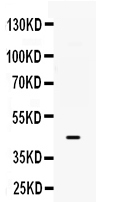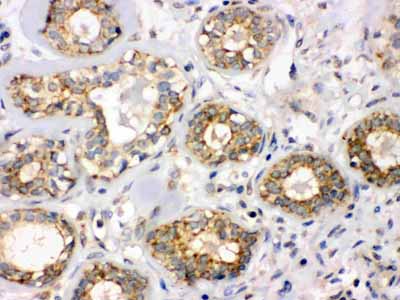Anti-B3GNT8 Picoband Antibody
- SPECIFICATION
- CITATIONS
- PROTOCOLS
- BACKGROUND

Application
| WB, IHC-P |
|---|---|
| Primary Accession | Q7Z7M8 |
| Host | Rabbit |
| Reactivity | Human |
| Clonality | Polyclonal |
| Format | Lyophilized |
| Description | Rabbit IgG polyclonal antibody for UDP-GlcNAc:betaGal beta-1,3-N-acetylglucosaminyltransferase 8(B3GNT8) detection. Tested with WB, IHC-P in Human. |
| Reconstitution | Add 0.2ml of distilled water will yield a concentration of 500ug/ml. |
| Gene ID | 374907 |
|---|---|
| Other Names | UDP-GlcNAc:betaGal beta-1, 3-N-acetylglucosaminyltransferase 8, BGnT-8, Beta-1, 3-Gn-T8, Beta-1, 3-N-acetylglucosaminyltransferase 8, Beta3Gn-T8, 2.4.1.-, B3GNT8 {ECO:0000312|EMBL:BAD86525.1} |
| Calculated MW | 43396 MW KDa |
| Application Details | Immunohistochemistry(Paraffin-embedded Section), 0.5-1 µg/ml, Human, By Heat Western blot, 0.1-0.5 µg/ml, Human |
| Subcellular Localization | Golgi apparatus membrane ; Single-pass type II membrane protein . |
| Tissue Specificity | Highly expressed in small intestine, pancreas, spleen, bone marrow, lung, throat, and ileum, and weakly in fetal brain, cerebellum, heart, liver, tongue, breast, uteri, and testis. Not detected in colon. Differentially expressed in human tumor cell lines. . |
| Protein Name | UDP-GlcNAc:betaGal beta-1,3-N-acetylglucosaminyltransferase 8 |
| Contents | Each vial contains 5mg BSA, 0.9mg NaCl, 0.2mg Na2HPO4, 0.05mg NaN3. |
| Immunogen | A synthetic peptide corresponding to a sequence at the C-terminus of human B3GNT8 (360-397aa ADRTADHCAFRNLLLVRPLGPQASIRLWKQLQDPRLQC), different from the related mouse sequence by sixteen amino acids. |
| Purification | Immunogen affinity purified. |
| Cross Reactivity | No cross reactivity with other proteins |
| Storage | At -20˚C for one year. After r˚Constitution, at 4˚C for one month. It˚Can also be aliquotted and stored frozen at -20˚C for a longer time.Avoid repeated freezing and thawing. |
| Name | B3GNT8 {ECO:0000312|EMBL:BAD86525.1} |
|---|---|
| Function | Beta-1,3-N-acetylglucosaminyltransferase that plays a role in the elongation of specific branch structures of multiantennary N- glycans. Has strong activity towards tetraantennary N-glycans and 2,6 triantennary glycans. |
| Cellular Location | Golgi apparatus membrane {ECO:0000250|UniProtKB:Q9NY97}; Single-pass type II membrane protein {ECO:0000250|UniProtKB:Q9NY97} |
| Tissue Location | Highly expressed in small intestine, pancreas, spleen, bone marrow, lung, throat, and ileum, and weakly in fetal brain, cerebellum, heart, liver, tongue, breast, uteri, and testis. Not detected in colon. Differentially expressed in human tumor cell lines |

Thousands of laboratories across the world have published research that depended on the performance of antibodies from Abcepta to advance their research. Check out links to articles that cite our products in major peer-reviewed journals, organized by research category.
info@abcepta.com, and receive a free "I Love Antibodies" mug.
Provided below are standard protocols that you may find useful for product applications.
Background
B3GNT8 is a galactosyltransferase involved in the synthesis of poly-N-acetyllactosamine (polyLacNAc), a linear chain of repeating LacNAc units made up of galactose (Gal) and N-acetylglucosamine (GlcNAc) with the structure (Gal-beta-1-4-GlcNAc-beta-1-3)n. By genomic sequence analysis, the B3GNT8 gene is mapped to chromosome 19q13.2. It was showed that a soluble form of B3GNT8 overexpressed by transfected HEK293 cells selectively transferred GlcNAc from UDP-GlcNAc to the nonreducing terminus of Gal-beta-1-4-GlcNAc-alpha-p-nitrophenyl phosphate and to lactoside-alpha-benzoyl. It did not utilize keratan sulfates or polylactosamine oligosaccharide as substrate. B3GNT8 activity required Mn(2+) and showed less efficiency with Co(2+). The pH optimum was between 7 and 7.5. B3GNT8 also transferred GlcNAc onto alpha-1-acid glycoprotein and ovomucoid, which possess tetraantennary complex type and pentaantennary complex type N-glycans. With a tetraantennary N-glycan substrate, B3GNT8 appeared to prefer the beta-1-2 branch over the beta-1-6 branch. When overexpressed in HCT15 human colon cancer cells, B3GNT8 increased cell surface expression of both polyLacNAc and beta-1-6-branched N-glycans.
If you have used an Abcepta product and would like to share how it has performed, please click on the "Submit Review" button and provide the requested information. Our staff will examine and post your review and contact you if needed.
If you have any additional inquiries please email technical services at tech@abcepta.com.













 Foundational characteristics of cancer include proliferation, angiogenesis, migration, evasion of apoptosis, and cellular immortality. Find key markers for these cellular processes and antibodies to detect them.
Foundational characteristics of cancer include proliferation, angiogenesis, migration, evasion of apoptosis, and cellular immortality. Find key markers for these cellular processes and antibodies to detect them. The SUMOplot™ Analysis Program predicts and scores sumoylation sites in your protein. SUMOylation is a post-translational modification involved in various cellular processes, such as nuclear-cytosolic transport, transcriptional regulation, apoptosis, protein stability, response to stress, and progression through the cell cycle.
The SUMOplot™ Analysis Program predicts and scores sumoylation sites in your protein. SUMOylation is a post-translational modification involved in various cellular processes, such as nuclear-cytosolic transport, transcriptional regulation, apoptosis, protein stability, response to stress, and progression through the cell cycle. The Autophagy Receptor Motif Plotter predicts and scores autophagy receptor binding sites in your protein. Identifying proteins connected to this pathway is critical to understanding the role of autophagy in physiological as well as pathological processes such as development, differentiation, neurodegenerative diseases, stress, infection, and cancer.
The Autophagy Receptor Motif Plotter predicts and scores autophagy receptor binding sites in your protein. Identifying proteins connected to this pathway is critical to understanding the role of autophagy in physiological as well as pathological processes such as development, differentiation, neurodegenerative diseases, stress, infection, and cancer.



